Microwave graphene syntheses and graphene-based artificial muscles
At LMSSC, Cnam, Paris, November 5th 2011, 11 a.m.
Il-Kwon Oh
Associate Professor, Director of Structural Dynamics and Smart Systems Laboratory
School of Mechanical, Aerospace and Systems Engineering, Korea Advanced Institute of Science and Technology (KAIST), Daejeon, Korea
Associate Professor, Director of Structural Dynamics and Smart Systems Laboratory
School of Mechanical, Aerospace and Systems Engineering, Korea Advanced Institute of Science and Technology (KAIST), Daejeon, Korea
Graphene, a single layer assembly of carbon atoms densely packed into a benzene ring structure have unique properties thus making it a potential material for applications in next-generation electronic devices, reinforced composites for electrical and thermal conduction, transparent electrodes for displays, solar cells, chemical and biological sensors, nano-composites and others. We developed eco-friendly techniques [1] for synthesis of graphene nano-sheets from various precursors like graphite, carbon nanotubes, and carbon fibers. One of our techniques can also be used to facile one-pot synthesis [2] of metal decorated graphene which can be used in variety of applications like sensors, actuators, surface enhanced raman spectra etc.
A novel approach to synthesize graphene nano-sheets by combining eco-friendly oxidizers like hydrogen peroxide and and microwave radiation has been developed [1-3]. Microwave radiation as external energy source was used to produce strong expansion of the graphite worm in the thickness direction. The graphene nano-sheets obtained in this study were characterized by morphology images, nanoprofilometry, Raman and X-ray photoelectron spectroscopy.
 SEM micrograph of microwave expanded graphene worm
|
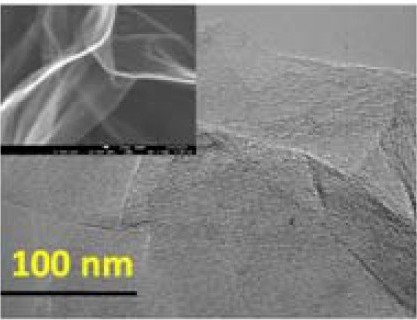 TEM micrograph of graphene nanosheet
|
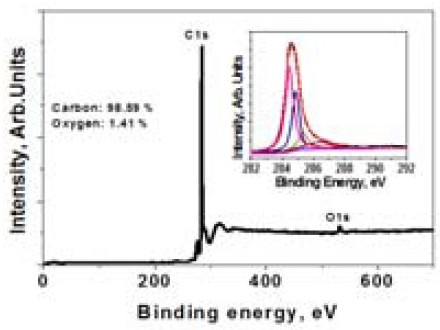 XPS spectra
|
 Raman spectra
|
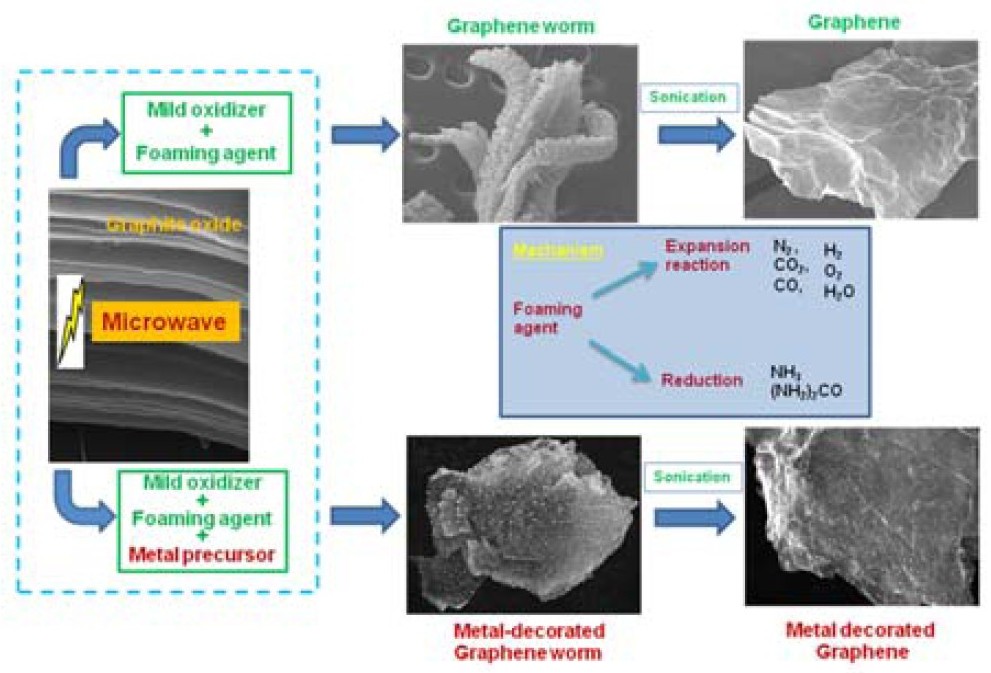
Schematic diagram of metal decorated graphenes
One advantage of our technique is that the bulk of oxygen impurities are driven away during this process resulting in graphene nano-sheets with minimal defects. In order to improve the yield and efficiency of our technique, we added eco-friendly foaming agent like azodicarbonamide (ADC) to improve the yield of graphene [4]. Under microwave radiation, the intercalated foaming agent plays a key role in the rapid and large expansion of the graphene worm along the thickness direction and in the reduction process of the graphite oxide. Also, with addition of metal precursors to the reactant mixture, this technique can also be extended to a one-pot method to synthesize metal-decorated graphene nano-hybrids. A variety of metal precursors was used to yield iron, platinum, and palladium decorated graphene nano-sheets.
The graphene nanoparticles and sheets can be applied to develop artificial muscles [5-10]. Also, we developed four different graphene-based actuators. GO-CNT bilayer actuator, G-Nafion IPMC actuator [11], ferromagnetic shape memory polymer actuator and transparent ionic polymer actuators will be introduced here.
 Self-assembled dispersion of graphene in Nafion
|
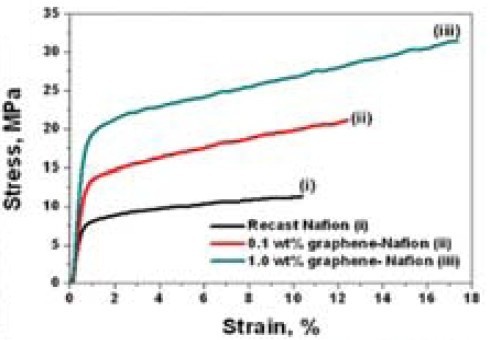 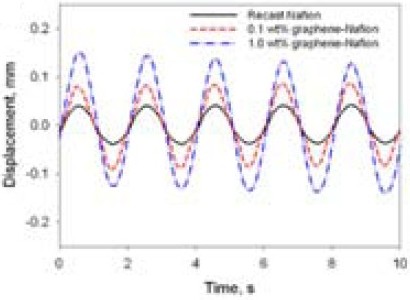 Tremendous increase in tensile strength even with minute addition of graphene
|
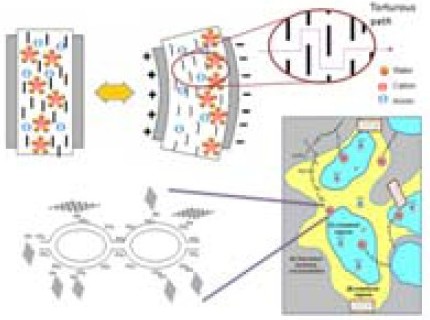
Tip-displacement of graphene-Nafion actuators
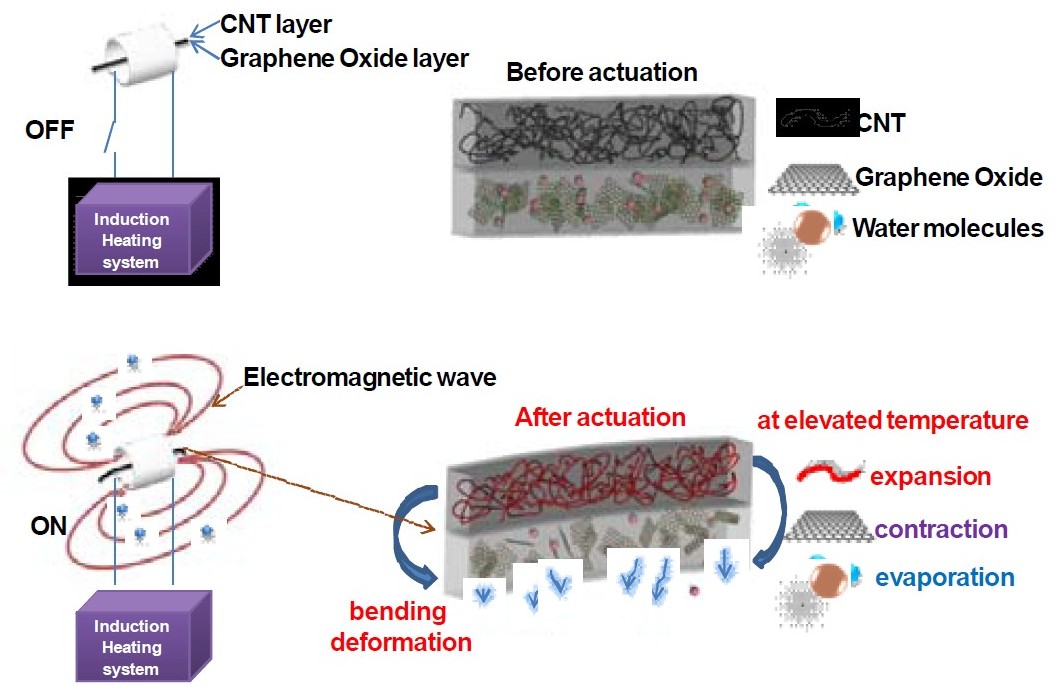
Schematic representation of actuation mechanism
References
| [1] | V. Sridhar, J.-H. Jeon, I.-K. Oh, Synthesis of graphene nano-sheets using eco-friendly chemicals and microwave radiation, Carbon, 48 (10), 2953-2957, 2010. |
| [2] | V. Sridhar, J.-H. Jeon, I.-K. Oh, Microwave extraction of graphene from carbon fibers, Carbon, 49 (1), 222-226, 2011. |
| [3] | V. Sridhar, I.-K. Oh, A coagulation technique for purification of graphene sheets with graphene-reinforced PVA hydrogel as byproduct, Journal of Colloid and Interface Science, 348 (2), 384-387, 2010. |
| [4] | V. Sridhar, J.-H. Jung, I.-K. Oh, One-pot syntheses of graphene and metal-decorated graphene nano-hybrids, Carbon, 2011, in press. |
| [5] | J. Lu, S.-G. Kim, S. Lee, I.-K. Oh, A Biomimetic Actuator Based on Ionic Networking Membrane of Poly(Styrene-alt-maleimide)-Incorporated Poly(vinylidene fluoride), Advanced Functional Materials, 18 (8), 1290-1298, 2008. |
| [6] | M. Rajagopalan, I.-K. Oh, Fullerenol-based electro-active artificial muscles utilizing biocompatible polyetherimide, ACS Nano, 5 (3), 2248-2256, 2011. |
| [7] | J. Li, V. Sridhar, C.-D. Kee, I.-K. Oh, Electrospun fullerenol-cellulose biocompatible actuators, Biomacromolecules, 12 (6), 2048-2054, 2011. |
| [8] | J.-H. Jeon, S.-P. Kang, S. Lee, I.-K. Oh, Novel biomimetic actuator based on SPEEK and PVDF, Sensors and Actuators B: Chemical, 143 (1), 357-364, 2009. |
| [9] | S.-W. Yeom, I.-K. Oh, A biomimetic jellyfish robot based on ionic polymer metal composite actuators, Smart Materials and Structures, 18 (8), 085002, 2009. |
| [10] | J. Song, J.-H. Jeon, I.-K. Oh, K.C. Park, Electro-active polymer actuator based on sulfonated polyimide with highly conductive silver electrodes via self-metallization, Macromolecular Rapid Communications, 32 (19), 1583-1587, 2011. |
| [11] | J.-H. Jung, J.-H. Jeon, V. Sridhar, I.-K. Oh, Electro-active graphene-Nafion actuators, Carbon, 49 (4), 1279-1289, 2011. |
